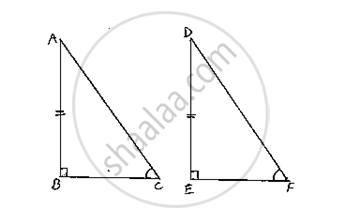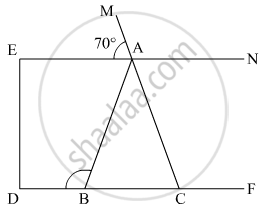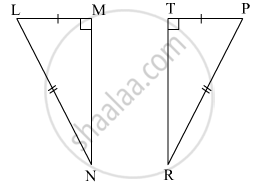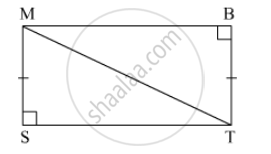Advertisements
Advertisements
प्रश्न
In two right triangles one side an acute angle of one are equal to the corresponding side and angle of the othe Prove that the triangles are congruent.
उत्तर
Given that, in two right triangles one side and acute angle of one are equal to the corresponding side and angles of the other.
We have to prove that the triangles are congruent. Let us consider two right triangles such that
∠B = ∠C = 90° ........(1)
AB = DE ........(2)
∠C = ∠F ........(3)
Now observe the two triangles ABC and DEF
∠.C = ∠F [From (3)]
∠B = ∠E [From (1)]
and AB = DE [From (2)]
So, by AAS congruence criterion, we have
ΔABC ≅ ΔDEF
∴The two triangles are congruent Hence proved

APPEARS IN
संबंधित प्रश्न
In a ΔABC, if AB = AC and ∠B = 70°, find ∠A.
In the given figure, if AE || DC and AB = AC, the value of ∠ABD is

In the following example, a pair of triangles is shown. Equal parts of triangles in each pair are marked with the same sign. Observe the figure and state the test by which the triangle in each pair are congruent.

By ______ test
Δ ABC ≅ ΔPQR
In the following example, a pair of triangles is shown. Equal parts of triangle in each pair are marked with the same sign. Observe the figure and state the test by which the triangle in each pair are congruent.

By ______ test
ΔLMN ≅ ΔPTR
In the pair of triangles given below, the parts shown by identical marks are congruent. State the test and the one-to-one correspondence of vertices by which the triangles in the pair are congruent, the remaining congruent parts.

In a triangle ABC, if D is midpoint of BC; AD is produced upto E such as DE = AD, then prove that:
a. DABD andDECD are congruent.
b. AB = EC
c. AB is parallel to EC
In the figure, ∠BCD = ∠ADC and ∠ACB =∠BDA. Prove that AD = BC and ∠A = ∠B.
“If two sides and an angle of one triangle are equal to two sides and an angle of another triangle, then the two triangles must be congruent.” Is the statement true? Why?
Is it possible to construct a triangle with lengths of its sides as 4 cm, 3 cm and 7 cm? Give reason for your answer.
If ∆PQR is congruent to ∆STU (see figure), then what is the length of TU?

